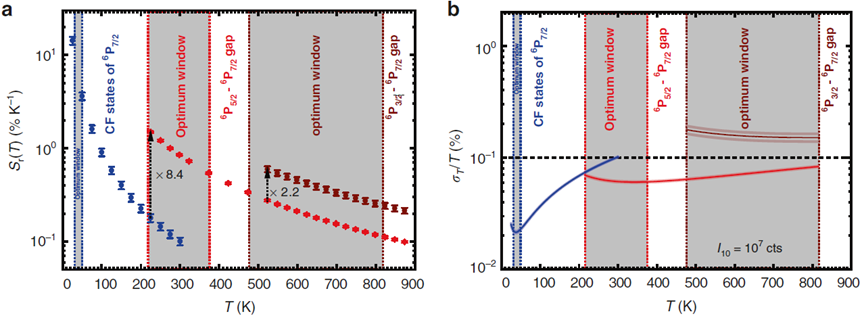December 14, 2021
| By Zhang Liu | Copyedited by William, Zhang Liu
Recently, directed by Academician Zhuang Songlin, Professor Yu Dechao, A Member of the Ultra-precision Optical Manufacture Team led by Professor Zhang Dawei published a research paper titled “One ion to catch them all: Targeted high-precision Boltzmann thermometry over a wide temperature range with Gd3+” in an international top journal: Light: Science & Applications in the optical field. This research realizes the high-precision measurement covering a temperature window between 30 and 800k.
Chemical reactions, biological functionalities, and various physical phenomena are all strongly determined by the local temperature. The measurement of local temperatures on successively smaller scales requires new methods of temperature sensing that rely on a remote detection principle. Several such concepts already exist. The most commonly known example is infrared (IR) thermography or pyrometry1–3, which only allows temperature measurements of surfaces of objects based on their emitted thermal radiation. According to the Stefan−Boltzmann law, the intensity of the emitted radiation scales with the fourth power of temperature and is expected to be sensitive for high temperatures and objects with high emissivity. An alternative method of remote temperature sensing is luminescence thermometry, which exploits the fact that luminescence properties such as the emission intensity orthe luminescence decay time are highly dependent on the local temperature of the surroundings of the luminescentspecies4–6. Boltzmann-based two-level thermometer only performs with sufficient statistical precision within a limited temperature range dependent on the energy gap ΔE21 between the two excited levels.

Professor Zhang Dawei and Professor Yu Dechao from Ultra-precision Optical Manufacture Team cooperated with experts from Utrecht University, University of Duesseldorf, South China University of Technology, Liaocheng University, extends the concept of Boltzmann thermometry to more than two excited levels and provide quantitative guidelines that link the choice of energy gaps between multiple excited states to the performance in different temperature windows. By this approach, it is possible to retain the high relative sensitivity and precision of the temperature measurement over a wide temperature range within the same system.

Researchers demonstrate this concept using YAl3(BO3)4 (YAB):Pr3+, Gd3+ with an excited 6PJ crystal field and spin-orbit split levels of Gd3+ in the UV range to avoid a thermal black body background even at the highest temperatures. This method allows us to cover a temperature window between 30 and 800k. This phosphor is easily excitable with inexpensive and powerful blue LEDs at 450nm. Zero-background luminescence thermometry is realized by using blue-to-UV energy transfer upconversion with the Pr3+-Gd3+ couple upon excitation in the visible range.
Link to the paper: https://www.nature.com/articles/s41377-021-00677-5


